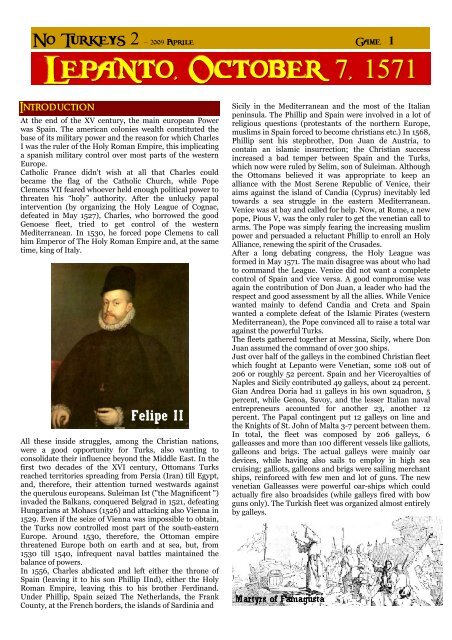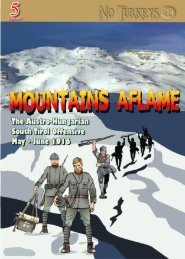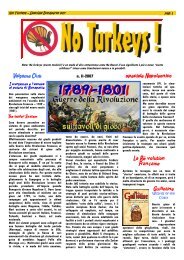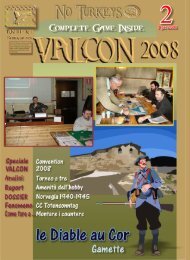Create successful ePaper yourself
Turn your PDF publications into a flip-book with our unique Google optimized e-Paper software.
<strong>No</strong> <strong>Turkeys</strong> 2 – <strong>2009</strong> Aprile Game 1<br />
Lepanto, October 7, 1571<br />
IInttroducttiion<br />
At the end of the XV century, the main european Power<br />
was Spain. The american colonies wealth constituted the<br />
base of its military power and the reason for which Charles<br />
I was the ruler of the Holy Roman Empire, this implicating<br />
a spanish military control over most parts of the western<br />
Europe.<br />
Catholic France didn't wish at all that Charles could<br />
became the flag of the Catholic Church, while Pope<br />
Clemens VII feared whoever held enough political power to<br />
threaten his “holy” authority. After the unlucky papal<br />
intervention (by organizing the Holy League of Cognac,<br />
defeated in May 1527), Charles, who borrowed the good<br />
Genoese fleet, tried to get control of the western<br />
Mediterranean. In 1530, he forced pope Clemens to call<br />
him Emperor of The Holy Roman Empire and, at the same<br />
time, king of Italy.<br />
All these inside struggles, among the Christian nations,<br />
were a good opportunity for Turks, also wanting to<br />
consolidate their influence beyond the Middle East. In the<br />
first two decades of the XVI century, Ottomans Turks<br />
reached territories spreading from Persia (Iran) till Egypt,<br />
and, therefore, their attention turned westwards against<br />
the querulous europeans. Suleiman Ist ("the Magnificent ")<br />
invaded the Balkans, conquered Belgrad in 1521, defeating<br />
Hungarians at Mohacs (1526) and attacking also Vienna in<br />
1529. Even if the seize of Vienna was impossible to obtain,<br />
the Turks now controlled most part of the south-eastern<br />
Europe. Around 1530, therefore, the Ottoman empire<br />
threatened Europe both on earth and at sea, but, from<br />
1530 till 1540, infrequent naval battles maintained the<br />
balance of powers.<br />
In 1556, Charles abdicated and left either the throne of<br />
Spain (leaving it to his son Phillip IInd), either the Holy<br />
Roman Empire, leaving this to his brother Ferdinand.<br />
Under Phillip, Spain seized The Netherlands, the Frank<br />
County, at the French borders, the islands of Sardinia and<br />
Sicily in the Mediterranean and the most of the Italian<br />
peninsula. The Phillip and Spain were involved in a lot of<br />
religious questions (protestants of the northern Europe,<br />
muslims in Spain forced to become christians etc.) In 1568,<br />
Phillip sent his stepbrother, Don Juan de Austria, to<br />
contain an islamic insurrection; the Christian success<br />
increased a bad temper between Spain and the Turks,<br />
which now were ruled by Selim, son of Suleiman. Although<br />
the Ottomans believed it was appropriate to keep an<br />
alliance with the Most Serene Republic of Venice, their<br />
aims against the island of Candia (Cyprus) inevitably led<br />
towards a sea struggle in the eastern Mediterranean.<br />
Venice was at bay and called for help. <strong>No</strong>w, at Rome, a new<br />
pope, Pious V, was the only ruler to get the venetian call to<br />
arms. The Pope was simply fearing the increasing muslim<br />
power and persuaded a reluctant Phillip to enroll an Holy<br />
Alliance, renewing the spirit of the Crusades.<br />
After a long debating congress, the Holy League was<br />
formed in May 1571. The main disagree was about who had<br />
to command the League. Venice did not want a complete<br />
control of Spain and vice versa. A good compromise was<br />
again the contribution of Don Juan, a leader who had the<br />
respect and good assessment by all the allies. While Venice<br />
wanted mainly to defend Candia and Creta and Spain<br />
wanted a complete defeat of the Islamic Pirates (western<br />
Mediterranean), the Pope convinced all to raise a total war<br />
against the powerful Turks.<br />
The fleets gathered together at Messina, Sicily, where Don<br />
Juan assumed the command of over 300 ships.<br />
Just over half of the galleys in the combined Christian fleet<br />
which fought at Lepanto were Venetian, some 108 out of<br />
206 or roughly 52 percent. Spain and her Viceroyalties of<br />
Naples and Sicily contributed 49 galleys, about 24 percent.<br />
Gian Andrea Doria had 11 galleys in his own squadron, 5<br />
percent, while Genoa, Savoy, and the lesser Italian naval<br />
entrepreneurs accounted for another 23, another 12<br />
percent. The Papal contingent put 12 galleys on line and<br />
the Knights of St. John of Malta 3-7 percent between them.<br />
In total, the fleet was composed by 206 galleys, 6<br />
galleasses and more than 100 different vessels like galliots,<br />
galleons and brigs. The actual galleys were mainly oar<br />
devices, while having also sails to employ in high sea<br />
cruising; galliots, galleons and brigs were sailing merchant<br />
ships, reinforced with few men and lot of guns. The new<br />
venetian Galleasses were powerful oar-ships which could<br />
actually fire also broadsides (while galleys fired with bow<br />
guns only). The Turkish fleet was organized almost entirely<br />
by galleys.






